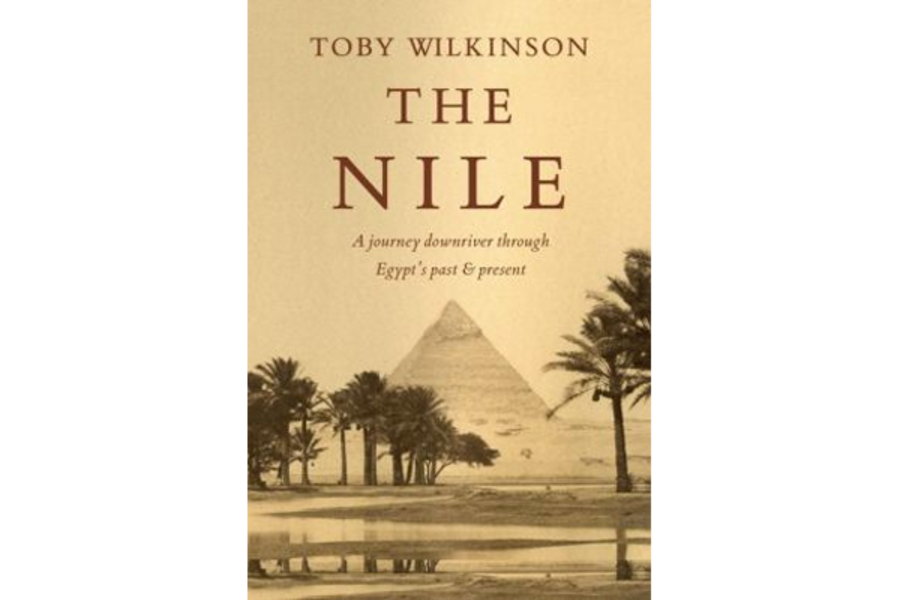'The Nile' is a trip through Egypt's history via its river
Loading...
When Gustave Flaubert visited the south of Egypt in 1849, he claimed the local Egyptians were using the temple of Horus at Edfu as a public latrine. While probably somewhat accurate, the accusation was not quite fair. Sand buried most of the temple until around 1860, and 64 modern houses stood on the temple roof. As in many areas around the world with a long history of human settlement, a modern neighborhood had emerged above a site of great antiquity.
From the 19th-century use of the Giza pyramids as stone quarries for construction in Cairo to the 20th-century Theban villagers who built houses above tomb shafts and sold the treasures from their "basements" for extra cash, many examples suggest that some Egyptians have been quite willing to use the artifacts of the past in service of their present needs.
But Flaubert's own countrymen often destroyed and stole ancient Egyptian antiquities without even the justification of convenience or cultural patrimony. A French engineer sawed a stunning zodiac from the temple of Dendera in 1821, and the French transported a 250-ton obelisk from Luxor to Paris a decade later. Looting and archaeology were often hard to distinguish in the 19th century.
Winding its way through Egypt, the Nile River shaped the ancient civilizations that continue to attract looters, archaeologists, and tourists alike. The river provides the structure for Egyptologist Toby Wilkinson's new book The Nile: A Journey Downriver Through Egypt's Past and Present.
The Greek historian Herodotus famously described Egypt as "the gift of the Nile," and Wilkinson shows the many senses in which the observation is true. The river's annual flooding not only initiated the ancient calendar year, it also watered the crops that made the otherwise austere landscape habitable. The Nile's imagery permeated ancient art and literature, its animals inspired religious practices – sacred crocodiles, anyone? – and its sunbaked mud furnished the principal building material for domestic architecture. Customs, food, houses, and art were all aspects of the Nile's gift.
Before the 2011 revolution, the seasonal influx of tourists to Egypt seemed to be a force at least as life-giving as the Nile’s annual flood. While roughly 90 percent of the ancient Egyptian economy involved agriculture, the figure has fallen to roughly 30 percent today, with tourism making up some of the difference. The dam at Aswan, built to improve agricultural yields through more precise control of irrigation, helped enable a population boom in the early 20th century. But its high walls also trapped silt that enriches soil quality, and chemical fertilizers are now needed to grow crops in much of the country.
The building of the dam submerged several known ancient monuments and countless ones that were still undiscovered. But if the Aswan Dam's construction was an example of the demands of the present overwhelming the claims of the past, many other instances reversed these priorities. Under Mubarak, an entire modern village in western Thebes was demolished and relocated to promote tourism.
Wilkinson ostensibly describes a journey down the Nile from Aswan in the south to Cairo in the north. But every site he visits triggers a series of reflections on details spanning the entire history of Egyptian civilization. Covering everything from rock art made 7500 years before the pyramids to the lore of 19th-century tomb-robbers and archaeologists, Wilkinson deftly illustrates the striated density of Egypt’s long past.
One of the central themes he pursues is the continuity of certain practices over long time periods. In southern Egypt, he spots mud brick baking in the sun outside ancient Nekheb's city wall, a structure which was made from identical mud bricks 2400 years before. Even the throngs of modern tourists have an ancient precedent. In Thebes, over 2000 ancient Greek and Roman graffiti have been recorded in the Valley of the Kings. The sentiments of ancient visitors are also familiar: one Greek graffito declares that its author has had "a delightful day" among tombs of "astounding horror." The same macabre pleasure still drives countless tourists to the tombs.
One thing that has changed is the level of danger faced by archaeologists. In the 19th century, Gertrude Caton-Thompson, the first prominent female Egyptologist, slept during excavations in an abandoned tomb beside a family of cobras. Flinders Petrie, the father of Egyptology, once tracked down a tomb-robber by following his footprints in the sand. But even here there is continuity: terrorist strikes in southern Egypt have made work difficult and visits dangerous for archaeologists and tourists.
Despite the many ways Egypt and the field of Egyptology have changed, the persistence of certain practices is inescapable. Around 7000 years ago, farmers in Fayum stored grain in plastered pits dug on their land. Archaeologists were anxious to preserve these early signs of agriculture, and the farmer on whose land they lay agreed at the last minute to work around them. He'd almost plowed over the earliest evidence of agriculture in Egypt.
Nick Romeo is a Monitor contributor.








